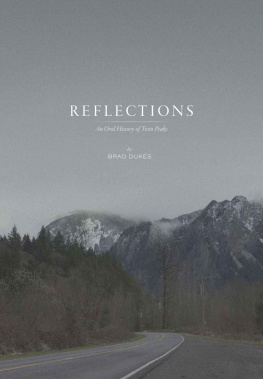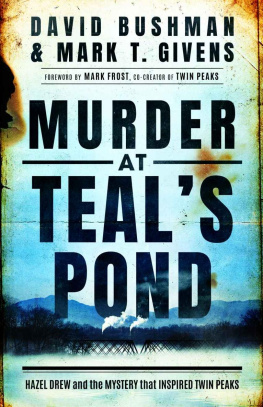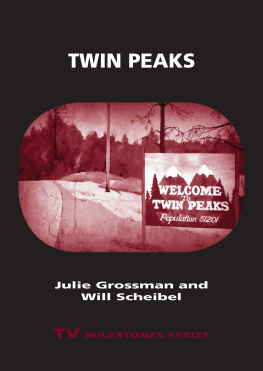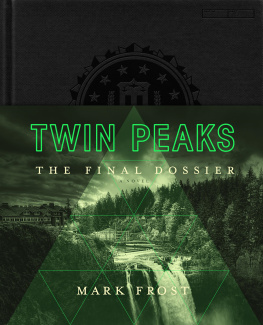An Oral History of Twin Peaks
by
BRAD DUKES
2014 by Brad Dukes
All rights reserved. No part of this publication may be reproduced, stored in a retrieval system, or transmitted, in any form by any means without the prior permission in writing of the publisher. Published in the United States by short/Tall Press, Nashville.
Publisher contact and information:
Cover, and original page design and typeset by Charles Ramsey
charlesville.us
Kindle programming, page design and typeset by Johnny Walker
www.johnnywalkerdesign.com
short/Tall Press is not licensed by nor affiliated with Lynch/Frost Productions, any studio, or production company.
Grateful acknowledgment is made to Howard Miller and John Thorne for permission to reprint excerpts where cited from the following articles originally published in Wrapped in Plastic magazine. All rights reserved. Reprinted by permission.
Miller, Craig and Thorne, John.
1993 Twin Peaks Fan Festival Wrapped in Plastic. October, 1993: 9
Miller, Craig and Thorne, John. Killer Bob Speaks
Wrapped in Plastic. December, 1993: 5-6
Complete photo credits and sources at conclusion of text.
LIBRARY OF CONGRESS CATALOGING-IN-PUBLICATION DATA
Dukes, Brad
Reflections : an oral history of twin peaks /
Brad Dukes
ISBN 978-0-615-96883-4 (pbk)
ISBN 978-0-692-28229-8 (ebk)
LCCN: 2014903072
Kindle version 1.0
Please report any formatting errors to
To Jessica
To my mother and father
And to Peyton
Authors Note
I will always remember a quiet summer night in August of 1990. I was nine years old, playing alone in the upstairs family room with my collection of action figures. I went downstairs for a Coke and noticed my mother was on the edge of her seat, as if she was about to be metaphysically absorbed by the tiny television set on the kitchen counter.
As I inched closer to the screen, I saw a dark figure moving through the woods at night and asked my mom what she was watching. Without taking her eyes off the television, she whispered, A girl has been killed and they are trying to find the murderer. I didnt dare leave the kitchen until the credits rolled.
In the following weeks, every new episode of Twin Peaks enchanted me with conflicted feelings of fear and fascination. I began hiding under the covers as I went to sleep every night, yet at school I covered my journal with drawings of ghostly giants, Have You Seen This Man? fliers, and a bespectacled lady cradling a log.
Almost twenty-five years later, Twin Peaks continues to fill me with wonder. I am compelled to document and preserve this brief chapter of television history that is unlike any other, before or since. It is my wish that this book brings you a little deeper into the world of Twin Peaks, a place that is both wonderful and strange.
Contents
1 | Kamikaze Pilot
2 | Welcome to Van Nuys
3 | The Happy Generations
4 | Side B
5 | Splinter
6 | Jaws of Life
Introduction
Countless television series have come and gone over the last sixty-five years, but few have managed to lead a profound and perplexing life as Twin Peaks. Six months before premiering on the American Broadcasting Company (ABC) in April of 1990, Twin Peaks was hyped as the series that may change it all on the cover of Connoisseur Magazine and a rogue wave of publicity was born.
Defying skeptical ABC executives, thirty-five million viewers tuned in for Twin Peaks broadcast debut. The tale of an enigmatic federal agent investigating the slaying of a small-town homecoming queen bewitched audiences and propelled the catchphrase Who killed Laura Palmer? into the national conversation.
A rabid cult of fans was born and a media circus stretched throughout the summer as stars of the show appeared on magazine covers and late-night talk shows with Johnny Carson and David Letterman. The frenzy became intoxicating as Twin Peaks received record-breaking Emmy nominations, won three Golden Globes, and spawned a book on the New York Times Best Seller list.
More than a routine crime procedural, Twin Peaks was capable of being melodramatic, hilarious, and downright terrifying within the span of minutes. Coffee, doughnuts, and cherry pie were consumed in mass quantities. A middle-aged woman with an eye patch was obsessed with inventing silent drape runners. A ponytailed truck driver attacked his wife with a bar of soap stuffed in a sock. Twin Peaks was unclassifiable and undefined, yet still engrossing to both viewers and critics yearning for the next generation of distinguished television.
Visitors Guide
The world of Twin Peaks is full of different people doing different things. Nearly one hundred individual voices are documented in the following text, and it may be challenging to keep it all straight. A brief description of the interviewees role is included before their first quote, and at the authors discretion. If you require further assistance, please reference the Census of all interview participants at the conclusion of this book.
Breaking Ground
This oral history begins in a nameless caf in Los Angeles, California, where David Lynch and Mark Frost first met. The two cocreators of Twin Peaks were first paired in the mid-1980s to collaborate on a film adaptation of Goddess, a Marilyn Monroe biography by author Anthony Summers. Lynch was a film director regarded for his midnight-cinema mainstay Eraserhead (1977) and his feature adaptations of The Elephant Man (1980) and Dune (1984). Frost was a seasoned screenwriter who had honed his craft working with television trailblazer Steven Bochco on the lauded police drama Hill Street Blues.
Mark Frost (series cocreator and executive producer): David and I were introduced by one of our mutual agents at CAA [Creative Artists Agency]; I believe it was in 1985. I remember it being at a coffee shop or a restaurant in Westwood, but David remembers it as somewhere else. My first impression of him was that he was a guy I felt completely in tune with. He was remarkably easy to get along with and it turned out we just had very compatible sensibilities.
Ken Scherer (former chief operating officer, Lynch/Frost Productions): Mark is a storyteller and David is an artist, thats really how I saw them perform. Whether it is Davids photography, his art, or his films hes very visual; hes very experiential. He makes you experience things you would not choose necessarily to experience. He sees the world in a very different way than most minds and Mark is a classic storyteller who chose film, TV, and novels to tell his stories. So, the two of them were a perfect combination. David had this vision that Mark could grab a hold of.
Jules Haimovitz (former president and chief operating officer, Spelling Entertainment): David and Mark are two of the greatest, most talented guys Ive met in this business. Their intelligence level is phenomenal. They were not spoiled Hollywood types in any way, shape, or form. This would be a whole different industry if everyone had their demeanor.
David was just a very creative sort who lets things roll off his back; he wasnt temperamental at all. He lives within his own mind and is just an interesting guy. Mark was more of like a college professor. He was very academic, a strong writer with strong story and character.









